User Guide
Introduction
Taking care of your finances has never been easier!
Spend N Split (SNS) is an application meant for managing transactions from your contacts list. Built for university students that reside on campus, it utilises your fast typing skills to help you maintain financial accountability between yourself and your peers. All you need to do, is to record your transactions in Spend N Split. Filtering, sorting, as well as the calculations of balances owed will be automatically handled by Spend N Split.
Spend N Split is perfect for you if you are
- A university student staying on campus.
- A fast typist.
- Comfortable using a keyboard to make full use of the application.
Table of Contents
- Introduction
- Table of Contents
- How to use the User guide
- Labels
- Key Terms
- Quick Start
- Navigating the App
- Parameters
- Features
- Data
- FAQ
- Acknowledgements
- Glossary
How to use the User Guide
-
If Spend N Split is not yet installed, kindly navigate to the Quick Start section, which includes steps for installation as well as sample commands for you to try.
-
If you are not yet familiar with Spend N Split and want a refresher, we highly recommend heading to the Navigating the App section.
-
Already an experienced user? Well, head to the Features section for a quick refresher on what Spend N Split can do for you!
Labels
In our user guide, you may find coloured boxes that contain highlighted pieces of text.
![]() Cyan boxes represent helpful tips to enhance your experience.
Cyan boxes represent helpful tips to enhance your experience.
![]() Blue boxes represent warnings that you should be cautious about.
Blue boxes represent warnings that you should be cautious about.
Key Terms
The Spend N Split application links transactions and people. As such, it is important that you familiarise yourself with the structure of each person and each transaction in our application.
Person
A person is someone that you track your balance against. Before creating a transaction involving a specific person, that person has to exist in the application. If not, that person has to be added to the application before the transaction is created.
A person has the following attributes:
- Name (Compulsory)
- Balance (Calculated by the application)
- Tag(s) (Optional)
- Phone number (Optional)
- Telegram handle (Optional)
- Email Address (Optional)
- Address (Optional)
Every person is identified by their name. Names are case-insensitive and the application does not support adding people with the same names. This means that you cannot add two or more people with the same name.
![]() If a positive balance is displayed on a person, it means that they owe you money. Conversely, if the balance displayed is
negative, you owe that person money instead.
If a positive balance is displayed on a person, it means that they owe you money. Conversely, if the balance displayed is
negative, you owe that person money instead.
Transaction
Transactions are events in which money is exchanged.
A transaction has the following attributes:
- Description (Compulsory)
- Payee (Compulsory)
- Payer (Compulsory)
- Amount (Compulsory)
- Timestamp (Optional. If this is not provided, the application will use the current system time of the computer for the Timestamp)
- Portion(s)
![]() There are 2 special names when adding transactions - “Self” and “Others”. “Self” refers to you (the user of this application) and “Others” refers to people that have not been added to the application.
There are 2 special names when adding transactions - “Self” and “Others”. “Self” refers to you (the user of this application) and “Others” refers to people that have not been added to the application.
After a transaction, each payer in the list of portions owes the payee a fraction of the amount, based on their weights in the list of portions.
Note: Spend N Split will only keep track of transactions that are considered relevant.
Quick Start
-
Ensure you have Java
11or above installed in your computer.To check the version of Java installed on your computer, click here if you are using a Windows or Mac computer, and click here if your computer is running Linux.
-
Download the latest
spendnsplit.jarfrom here. -
Copy the file to the folder you want to use as the home folder for your Spend N Split.
-
Open a command terminal,
cdinto the folder you put the jar file in, and use thejava -jar spendnsplit.jarcommand to run the application.
A GUI similar to the one shown below should appear in a few seconds. Note how the application contains some sample data.

-
Type the command in the Command Input Field and press Enter to execute it. e.g. typing
helpand pressing Enter will open the help window.
Some example commands you can try:-
listPerson: Lists all persons. -
listTransaction: Lists all transactions. -
exit: Exits the application.
-
- Learn more about navigating the application in the Navigating the App section below.
- Learn more about the commands in the Features section below.
Navigating the App
Spend N Split has an intuitive Graphical User Interface (GUI) that allows you to navigate the application easily.
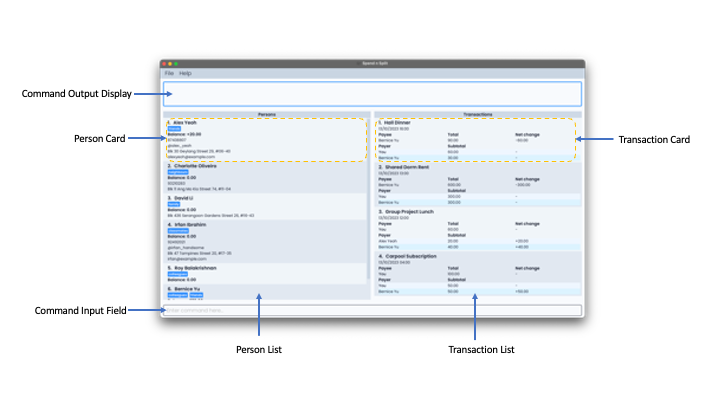
| Component | Description |
|---|---|
| Command Input Field | Type commands here and press Enter to execute them. |
| Command Output Display | Shows the result of the command execution. |
| Transaction List | Shows a list of transactions. The list can be filtered and sorted by the user. |
| Transaction Card | Shows the details of a transaction. Details include the description, date, payee, as well as the breakdown of costs. |
| Person List | Shows a list of persons. The list can be filtered and sorted by the user. |
| Person Card | Shows the details of a person. Details include name, balance, phone number, etc. |
Parameters
Some of our commands require parameters, which have specific formats and constraints applied on them. Before heading to the Features section, we recommend taking a look at the type of parameters required by commands.
The following parameters are used for commands:
| Parameter | Prefix | Format | Example |
|---|---|---|---|
| Index | - | Positive integers only |
1, 2, 3
|
| Keyword | - | Should not contain the “=” sign as mentioned above. No other restrictions |
Bob, Lunch
|
| Name | n | Alphanumeric, can contain multiple words |
Bob, Alex Yeoh
|
| Phone number | p | Numeric, minimum length of 3 digits |
99999999, 88888888
|
| Telegram handle | tg | Starts with @, followed by a minimum of 5 alphanumeric characters or underscores |
@nus_cs2103 , @spend_n_split
|
| Email address | e | Valid email format only |
damithch@comp.nus.edu.sg, dcsdcr@nus.edu.sg
|
| Address | a | Should not contain the “=” sign as mentioned above. No other restrictions |
Kent Ridge Hall, RC4
|
| Tag | t | Single-word, alphanumeric |
friend, colleague
|
| Description | d | Should not contain the “=” sign as mentioned above. No other restrictions |
Lunch, Dinner @ UTown
|
| Amount/ Cost | c | Positive rational numbers either in decimal or fraction format. Spaces are allowed |
12, .5, 0.5/3, 1.25 / 1.56, 12 000 000
|
| Timestamp | ts | Dates should be formatted as DD/MM/YYYY, and time as HH:MM. You have the option to include only the date or time, or both. When providing both, ensure that the date precedes the time, with a space in between |
12:12, 31/12/2020, 28/02/2021 00:00
|
| Weight | w | Positive rational numbers either in decimal or fraction format. Spaces are allowed |
12, .5, 0.5/3, 1.25 / 1.56, 12 000 000
|
| Original command | o | An original command keyword listed in this user guide |
setShorthand, addTransaction
|
| Shorthand | s | Single-word, English alphabet characters only |
s, aT
|
Spend N Split checks the validity of Telegram handles and email addresses according to the formats defined in the table above. It will reject all Telegram handles and email addresses that do not follow the format.
Features
![]() Notes about the command format:
Notes about the command format:
-
Words in
UPPER_CASEare the parameters to be supplied by the user.
E.g. InaddPerson n=NAME,NAMEis a parameter to be provided by the user.
Example usage:addPerson n=John Doe. -
Items in square brackets are optional.
E.g. Forn=NAME [t=TAG]:
Example usagen=John Doe t=friendorn=John Doe. -
Items followed by
…are optional and can be listed multiple times.
E.g. For[t=TAG]…:
Example usage: “ “ (0 tags), ort=friend(1 tag) ort=friend t=family(2 tags). -
If it is mentioned that the order of the parameters is flexible, it means that parameters can be in any order.
E.g. Forn=NAME p=PHONE
Example usage:n=Bob p=91722828orp=91722828 n=Bobare both accepted and will be treated as equivalent inputs by the application. -
Unnecessary parameters provided for commands (such as
help,clear,exit) that do not accept them will be disregarded.
E.g. for the commandhelpwhich does not accept any parameters, entering the commandhelp 123will be interpreted by the application ashelp. -
If you are using a PDF version of this document, be careful when copying and pasting commands. Space characters such as “ “ may result in errors. It is recommended that commands are manually copied and typed into the application.
Person-related features
Adding a person: addPerson
Adds a person to the application.
Format: addPerson n=NAME [p=PHONE] [tg=TELEGRAM_HANDLE] [e=EMAIL] [a=ADDRESS] [t=TAG]…
The command word (addPerson) has to be at the front of the command. The order of the remaining parameters is flexible.
After the command has been executed, every person in the application will be displayed in the Person List.
Examples:
addPerson n=John Doe p=98765432 e=johnd@example.com a=John street, block 123, #01-01addPerson n=Betsy Crowe t=friend e=betsycrowe@example.com a=London Block 55 p=1234567 t=London
Note: Only the name is compulsory when adding a person. After a person has been added to the application, more attributes to that person can be added using the editPerson command.
Once an attribute has been added to a person, it can only be edited and cannot be deleted, except for the tags of a person (as elaborated below under Editing a person).

Editing a person : editPerson
Edits an existing person in the application.
Format: editPerson INDEX [n=NAME] [p=PHONE] [tg=TELEGRAM_HANDLE] [e=EMAIL] [a=ADDRESS] [t=TAG]…
The command word (editPerson) and the index has to be at the front of the command. The order of the remaining parameters is flexible.
- Edits the person at the specified
INDEX. The index refers to the index number shown in the displayed Person List. The index must be a positive integer 1, 2, 3, … - At least one of the optional parameters must be provided.
- Existing values will be updated to the input values.
- When editing tags, the existing tags of the person will be removed i.e. adding of tags is not cumulative.
- You can remove all the person’s tags by typing
t=without specifying any tags after it. However, this will only work if there is a single tag parameter.t=will work, butt=Friend t=will result in an input error.
After the command has been executed, every person in the application will be displayed in the Person List.
Examples:
-
editPerson 1 p=91234567 e=johndoe@example.com- Edits the phone number and email address of the 1st person to be
91234567andjohndoe@example.comrespectively.
- Edits the phone number and email address of the 1st person to be
-
editPerson 2 n=Betsy Crower t=- Edits the name of the 2nd person to be
Betsy Crowerand clears all existing tags.
- Edits the name of the 2nd person to be
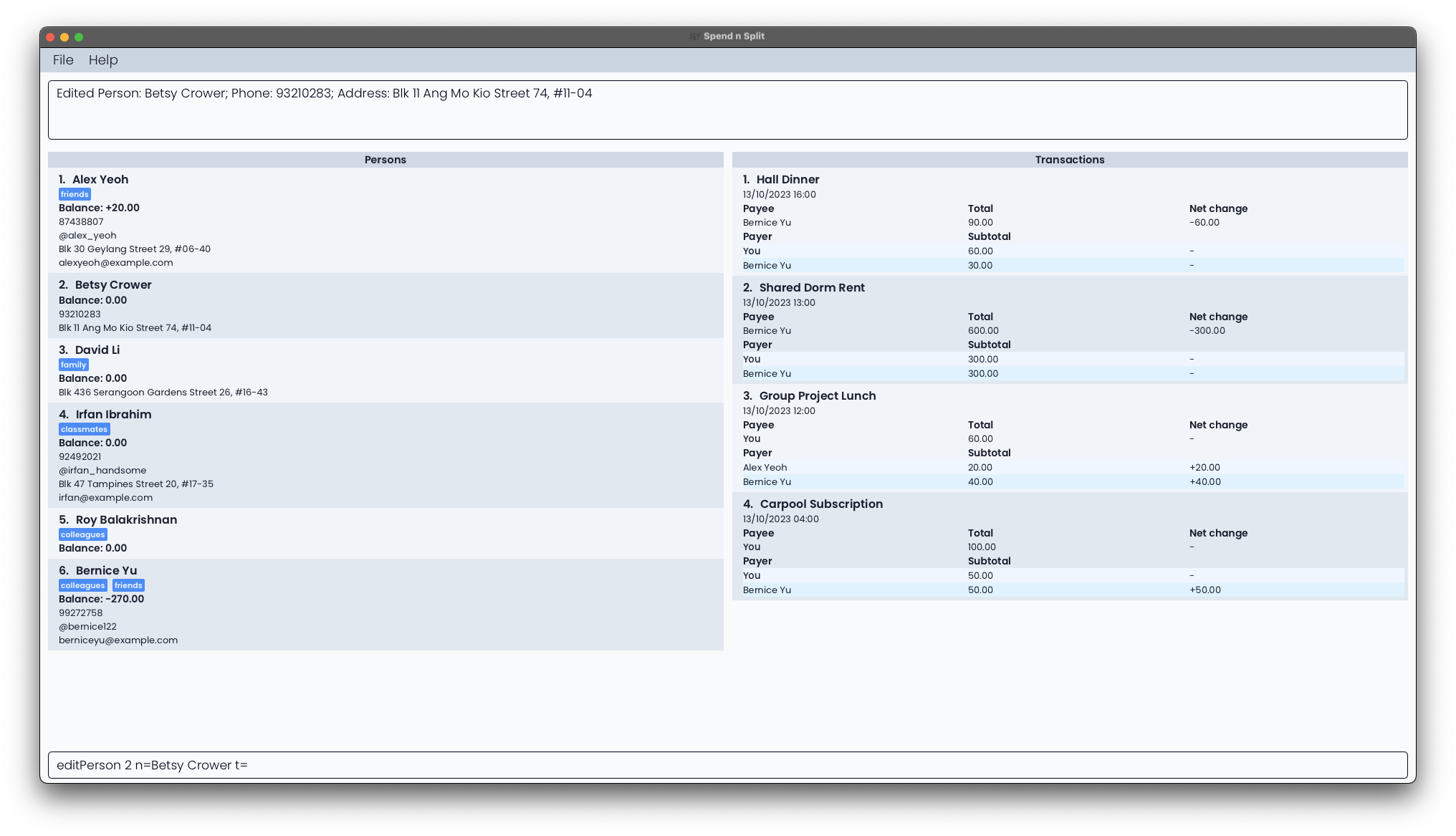
Deleting a person : deletePerson
Deletes the specified person from the application.
Format: deletePerson INDEX
- Deletes the person at the specified
INDEX. - The index refers to the index number shown in the displayed Person List.
- The index must be a positive integer 1, 2, 3, …
- Transactions involving the deleted person will have the deleted person’s name changed to “Others”. In the event that this results in the transaction becoming irrelevant, the transaction will be automatically deleted. All transactions involving the deleted person as a payee will also be automatically deleted.
Examples:
-
listPersonfollowed bydeletePerson 6deletes the 6th person in the application. -
listPerson alexfollowed bydeletePerson 1deletes the 1st person in the results of thelistPerson alexcommand.
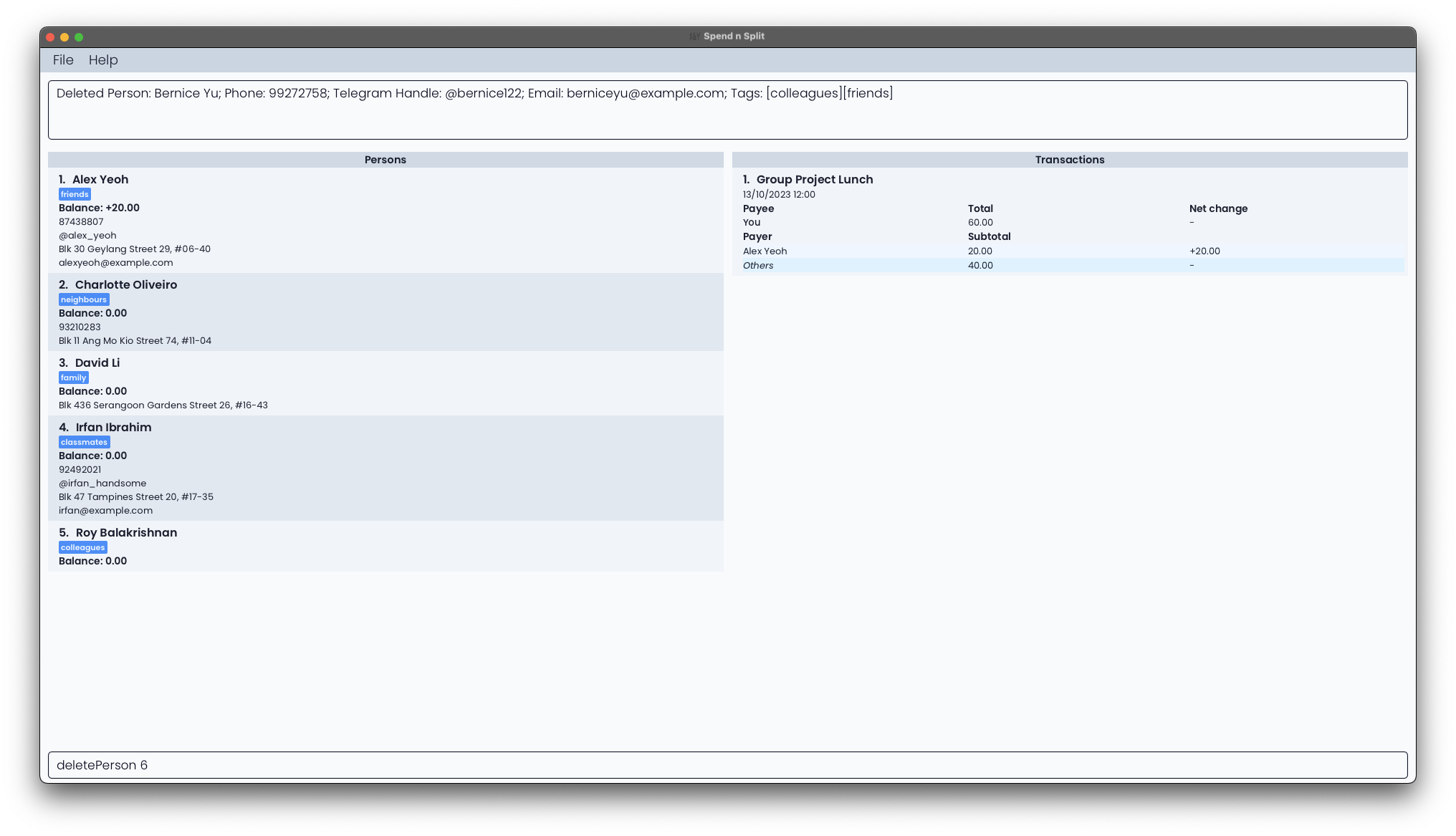
Locating persons by name: listPerson
Lists every person whose name contain any of the given keywords. If no keywords are entered, every person is listed.
Format: listPerson [KEYWORD]...
- The search is case-insensitive. e.g.
hanswill matchHans. - The order of the keywords does not matter. e.g.
Hans Bowill matchBo Hans. - Only the entire keyword will be matched e.g. A person named
Hanwill not be displayed whenlistPerson Hansis executed. - If a person’s name matches at least one keyword, they will be displayed.
E.g.
listPerson Hans Bowill result in bothHans GruberandBo Yangbeing displayed, should both of them already exist in the application.
Examples:
-
listPersonshows every person in the application. -
listPerson alex davidshowsAlex YeohandDavid Li.

Sorting persons by balance: sortPerson
Sorts the list of persons in the application based on their outstanding balances in either ascending or descending order. This allows you to quickly identify who owes the most or the least amount of money. Having a negative balance with someone means you own them money.
Format: sortPerson ORDER
Parameters:
-
ORDER: Specifies the order in which to sort the balances. Use-for ascending order (Largest negative balance at the top) and+for descending order (Largest positive balance at the top).
Examples:
-
sortPerson -- This command will rearrange the Person List in ascending order.
-
sortPerson +- This command will rearrange the Person List in descending order.
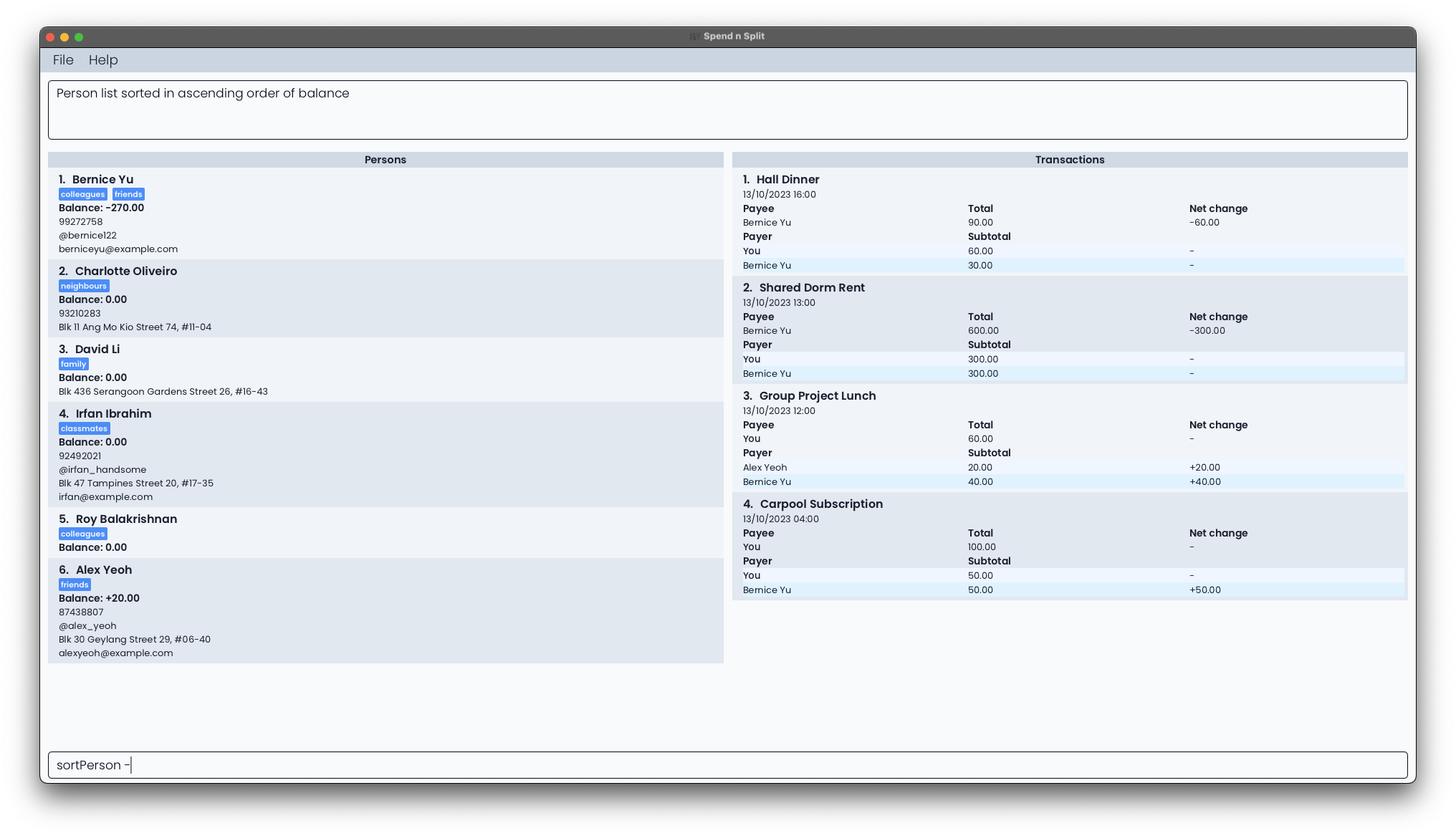
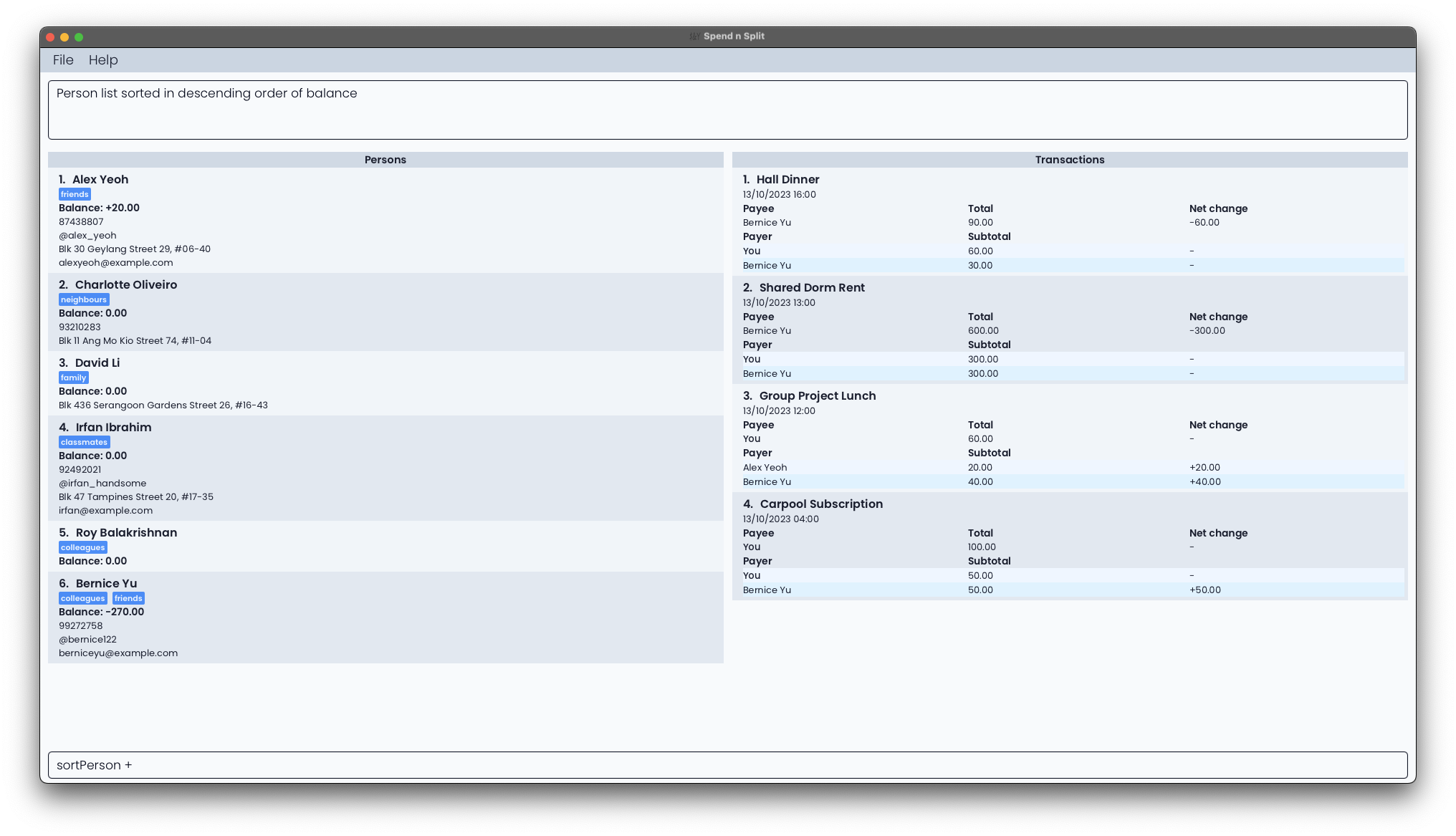
Transaction-related features
Adding a transaction: addTransaction
Adds a transaction for multiple persons with customised split ratios.
Format: addTransaction d=DETAILS n=NAME c=COST [ts=TIME] [n=NAME w=WEIGHT]...
- Cost and weights have to be decimal numbers or fractions, and they must be positive.
- The first name refers to the payee (that is the person whom everyone else now owes money).
- If the timestamp is not provided, the default time is the current system time.
- If only the date is given, the default time is set as
00:00. - If you want to reference yourself, use
n=Self. - At least one pair of name and weight must be provided.
- Payer names should not repeat. E.g.
n=Bob w=1.0 n=Bob w=2.0will be invalid. However, you are allowed to key in multiple portions for “Others” - the final weight for “Others” will be the sum of all the weights of the “Others” portions keyed in. - The cost for each person is calculated as follows:
Individual Cost = Total Cost * (Individual Weight / Total Weight)
After the command has been executed, every transaction in the application will be displayed in the transaction list.
![]() Transactions added to Spend N Split must be relevant. Refer to the Relevant Transactions section for more details.
Transactions added to Spend N Split must be relevant. Refer to the Relevant Transactions section for more details.
Examples:
-
addTransaction d=Rent n=David Li c=600 ts=10/10/2020 12:00 n=Self w=1 n=David Li w=1 n=Alex Yeoh w=1- A transaction for rent that cost $600 is added. David Li paid for this transaction at 12pm on 10 October 2020. You (
Self) and Alex Yeoh both owe David Li $200 (1/3 of $600) each.
- A transaction for rent that cost $600 is added. David Li paid for this transaction at 12pm on 10 October 2020. You (
-
addTransaction d=Dinner n=Self c=100 n=David Li w=2 n=Bernice Yu w=2 n=Alex Yeoh w=1- A transaction for dinner that cost $100 is added. You (
Self) paid for this transaction. David Li and Bernice Yu both owe you (Self) $40 (2/5 of $100) each, while Alex Yeoh owes you (Self) $20 (1/5 of $100).
- A transaction for dinner that cost $100 is added. You (
Sample execution:
$ addTransaction c=200 d=Textbooks
Invalid command format!
addTransaction: Adds a transaction.
Parameters: d=DESCRIPTION n=NAME c=COST [ts=TIME] [n=NAME w=WEIGHT]...
Example: addTransaction d=bread n=John Doe c=25.00 ts=10/10/2020 12:00
n=Self w=1.5 n=John Doe w=1
$ addTransaction d=Rent n=David Li c=600 ts=10/10/2020 12:00
n=Self w=1 n=David Li w=1 n=Alex Yeoh w=1
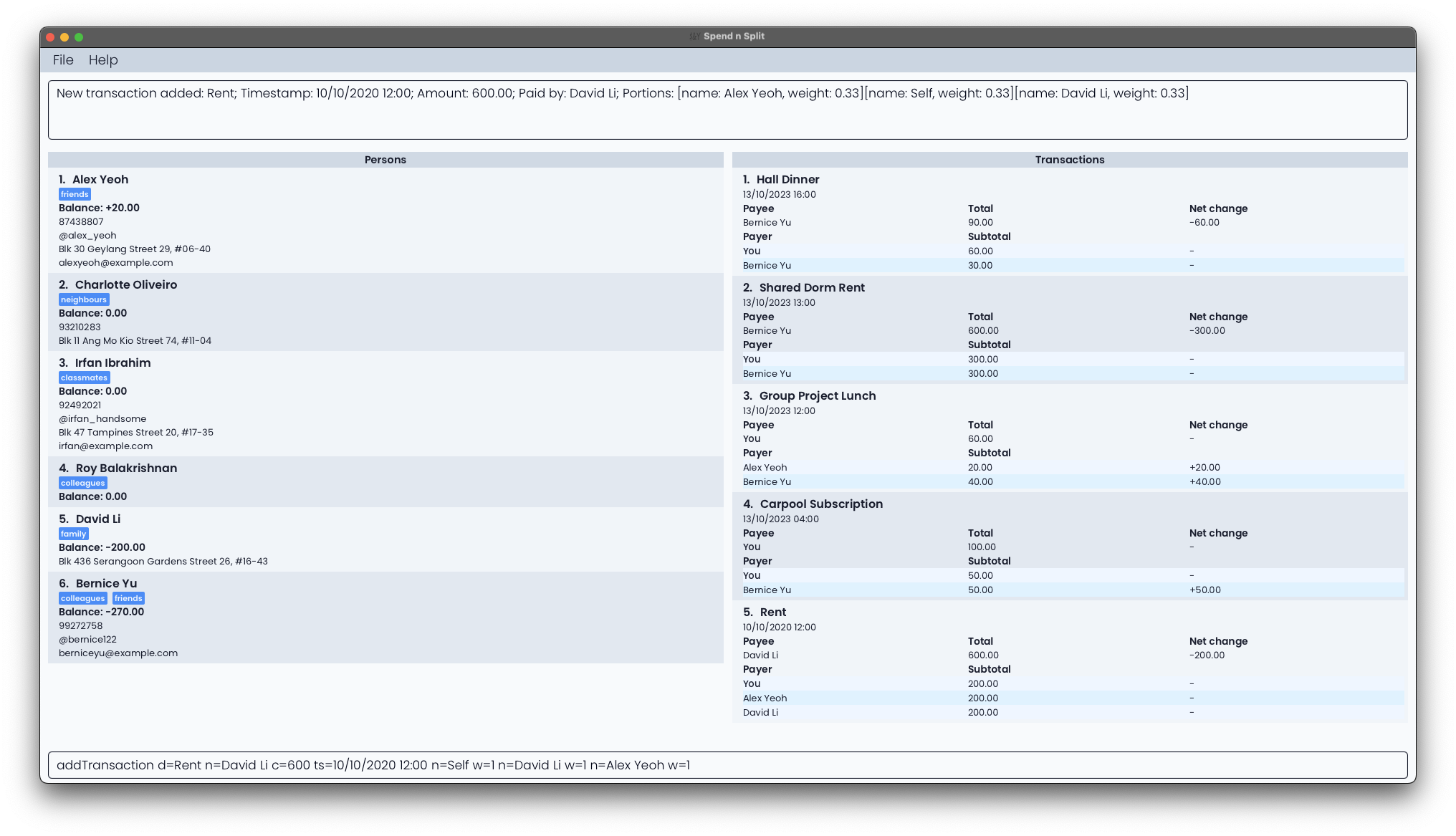
Editing a transaction: editTransaction
Edits the transaction at the specified INDEX.
Transaction details that can be edited:
- Description
- Cost
- Payee
- Timestamp
Format: editTransaction INDEX [d=DESCRIPTION] [c=COST] [n=PAYEE] [ts=TIME]
The command word (editTransaction) and the index has to be at the front of the command. The order of the remaining parameters is flexible.
- Edits the transaction at the specified
INDEX. The index refers to the index number shown in the displayed transaction list. The index must be a positive integer 1, 2, 3, … - At least one of the optional fields must be provided.
- Existing values will be updated to the input values.
- If the Timestamp is provided as a parameter but only the date is given, the default time will be set to 00:00.
- A transaction cannot be edited to be irrelevant.
After the command has been executed, every transaction in the application will be displayed in the transaction list.
![]() After editing, the transaction must be relevant. The application will not allow you to edit a transaction such that it becomes irrelevant. Refer to the Relevant Transactions section for more details.
After editing, the transaction must be relevant. The application will not allow you to edit a transaction such that it becomes irrelevant. Refer to the Relevant Transactions section for more details.
Examples:
-
editTransaction 1 c=100 ts=14/10/2023 17:00- Edits the 1st transaction in the displayed list to have a cost of $100 and a timestamp of 14 October 2023, 5pm.
Sample Execution:
editTransaction 1 c=100 ts=14/10/2023 17:00
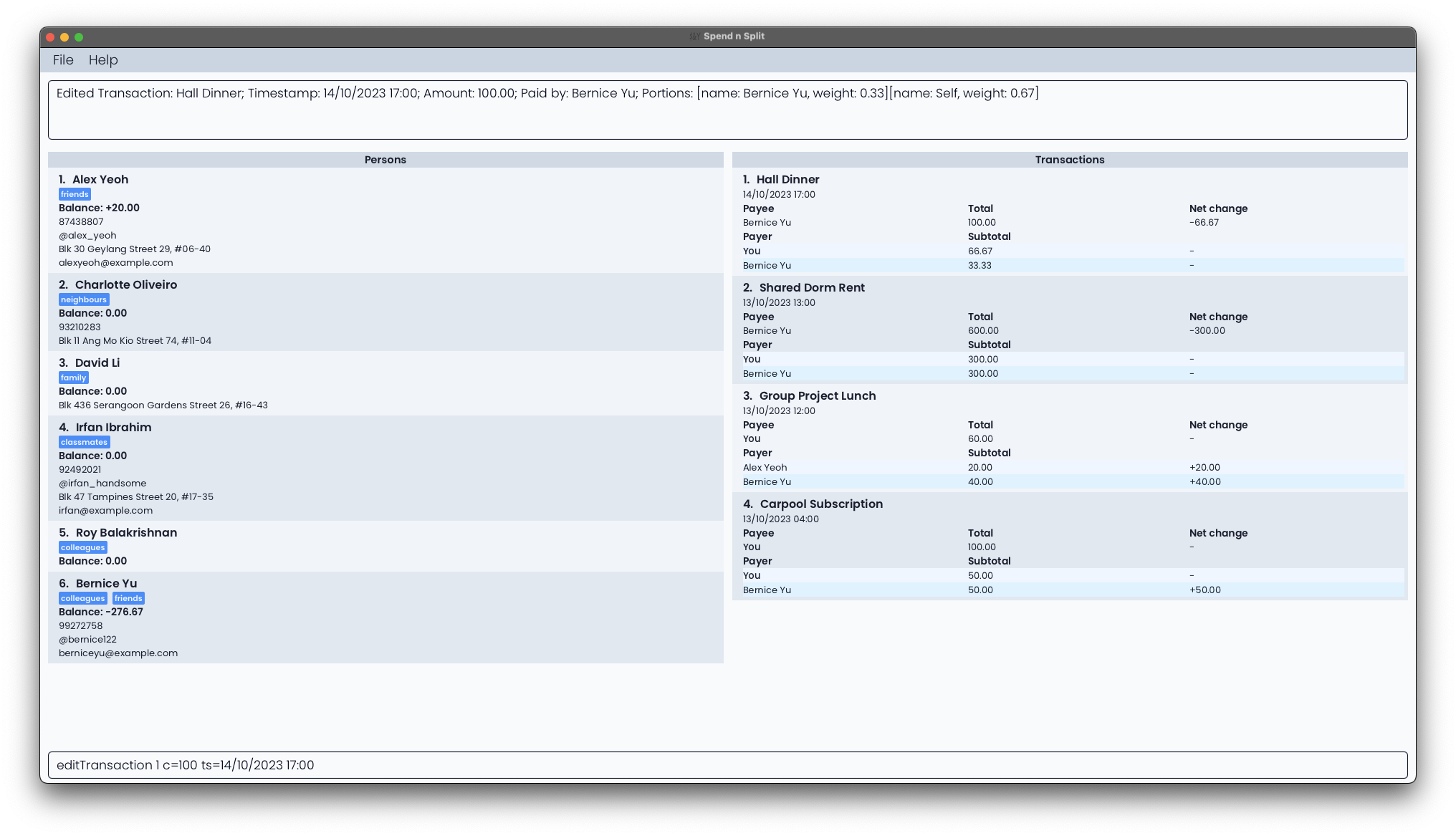
Updating the portion of a transaction: updatePortion
Updates the portion of a transaction at the specified INDEX. The index refers to the index number shown in the displayed transaction list. The index must be a positive integer 1, 2, 3, …
Portion refers to the amount of money that a payer owes the payee for a transaction.
The portion is calculated based on the cost of the transaction and the proportion of the transaction that the person has
to pay for, which is determined by the WEIGHT of the person. Hence, the WEIGHT must be between 0 (inclusive) and 1 (exclusive).
After the command has been executed, every transaction in the application will be displayed in the transaction list.
Format: updatePortion INDEX n=NAME w=WEIGHT
The command word (updatePortion) and the index has to be at the front of the command. The order of the remaining parameters is flexible. Examples:
- To add a new person (e.g. David Li) to the transaction:
updatePortion 3 n=David Li w=0.5
- To edit the weight of an existing person (e.g. Bernice Yu) in the transaction:
updatePortion 3 n=Bernice Yu w=0.5
- To remove an existing person (e.g. Bernice Yu) from the transaction, set the weight to 0:
updatePortion 3 n=Bernice Yu w=0
The calculation of subtotals for people involved in the affected transaction (excluding the person specified in the command) follows these steps:
1) Take the number 1 and subtract the weight that was given in the updatePortion command.
2) Take the resulting number from Step 1 and multiply it by the Total of the transaction to give a value remainingTotal.
3) Let the total summed-up weights of all the people in the affected transaction (excluding the person mentioned in the command) be remainingWeights.
4) For each of the people in the affected transaction (excluding the person mentioned in the command), their new subtotal will be their (existing weight / remainingWeights) * remainingTotal.
Sample Execution:
updatePortion 3 n=David Li w=0.5
Updated Portion: Group Project Lunch; Timestamp: 13/10/2023 12:00;
Amount: 60.00; Paid by: Self;
Portions: [name: Bernice Yu, weight: 0.33]
[name: David Li, weight: 0.50]
[name: Alex Yeoh, weight: 0.17]

Deleting a transaction: deleteTransaction
Deletes the specified transaction based on index.
Format: deleteTransaction INDEX
- The index refers to the index number shown in the displayed transaction list. The index must be a positive integer 1, 2, 3, …
Examples:
-
deleteTransaction 1- Deletes the 1st transaction in the displayed list.
Sample Execution:
$ deleteTransaction 1
Deleted Transaction: Hall Dinner; Timestamp: 13/10/2023 16:00;
Amount: 90.00; Paid by: Bernice Yu;
Portions: [name: Bernice Yu, weight: 0.33][name: Self, weight: 0.67]

Duplicating a Transaction: duplicateTransaction
Duplicates the transaction at the specified INDEX. The duplicated transaction’s timestamp will be the time at which
this command is executed. The index refers to the index number shown in the displayed transaction list.
The index must be a positive integer 1, 2, 3, …
Transaction details that can be changed when duplicating:
- Description
- Cost
- Payee
- Timestamp
Format: duplicateTransaction INDEX [d=DESCRIPTION] [c=COST] [n=PAYEE] [ts=TIME]
The command word (duplicateTransaction) and the index has to be at the front of the command. The order of the remaining parameters is flexible.
Examples:
-
duplicateTransaction 1- Creates a new transaction that is identical to the 1st transaction in the displayed list, except for the timestamp of the new transaction being the time at which this command was executed.
-
duplicateTransaction 2 c=20.5 d=Shared Lunch- Creates a new transaction that is identical to the 2nd transaction in the displayed list, except for the timestamp of the new transaction being the time at which this command was executed, the cost of the new transaction being $20.50, and the description of the new transaction being “Shared Lunch”.
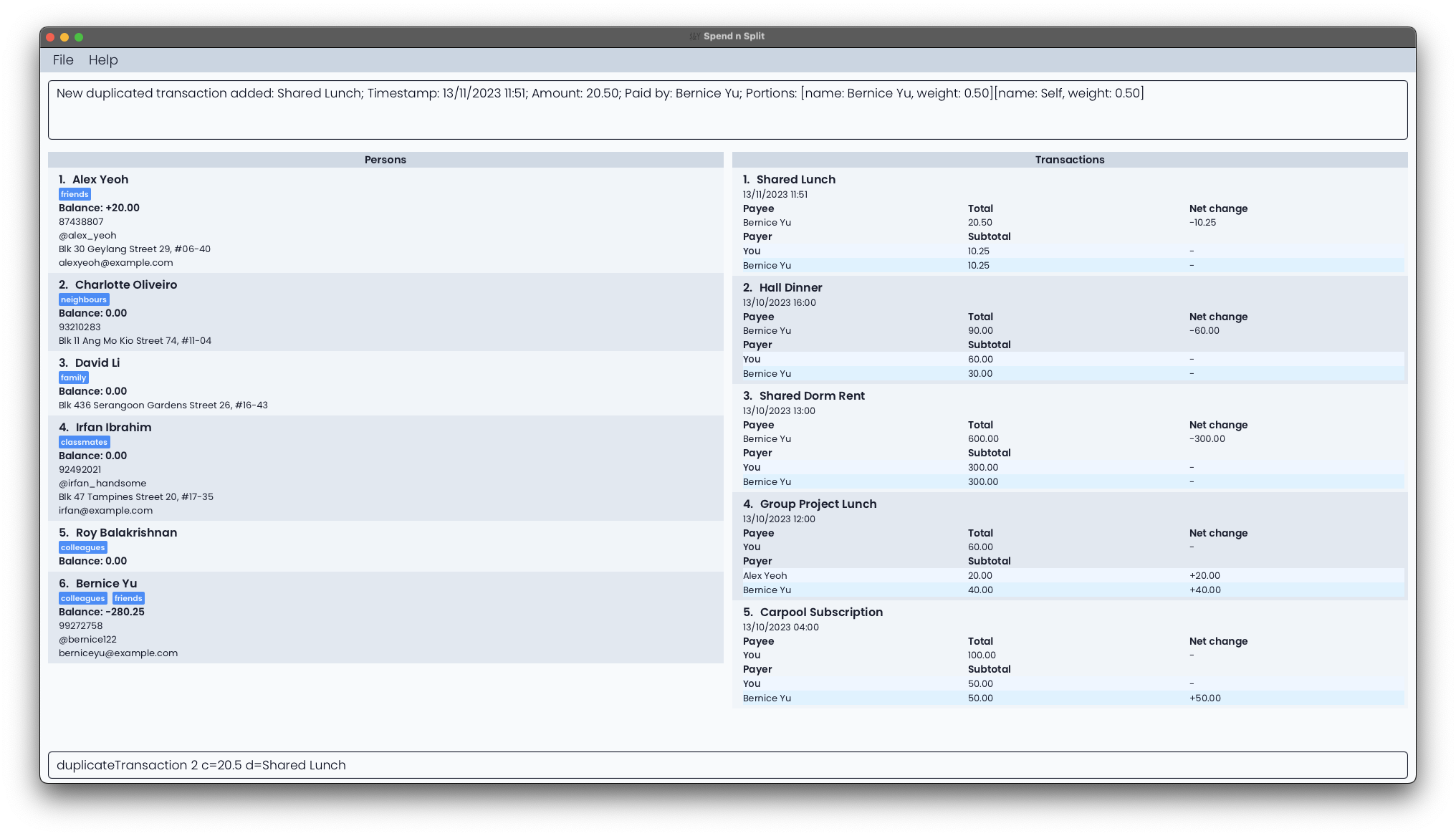
Listing transactions: listTransaction
Shows a list of transactions whose descriptions include any of the keywords and which include any of the specified people. If no keywords are specified, it filters only by names; if no names are specified, it filters only by keywords. If neither are specified, all transactions will be listed.
Format: listTransaction [KEYWORD]... [n=NAME]...
- The name refers to the name of the person in the transaction (either as a payee or a payer).
- The name must contain only alphabets, numbers, and spaces. It cannot be empty and is case-insensitive.
Examples:
-
listTransaction- Shows all transactions.
-
listTransaction Lunch n=Alice Pauline n=Carl Kurz- Shows all transactions that include Alice Pauline or Carl Kurz as a payee or payer, and whose descriptions include the keyword “Lunch”.
Sample Execution:
$ listTransaction
4 transaction(s) listed!

$ listTransaction Dinner n=Bernice Yu
1 transaction(s) listed!
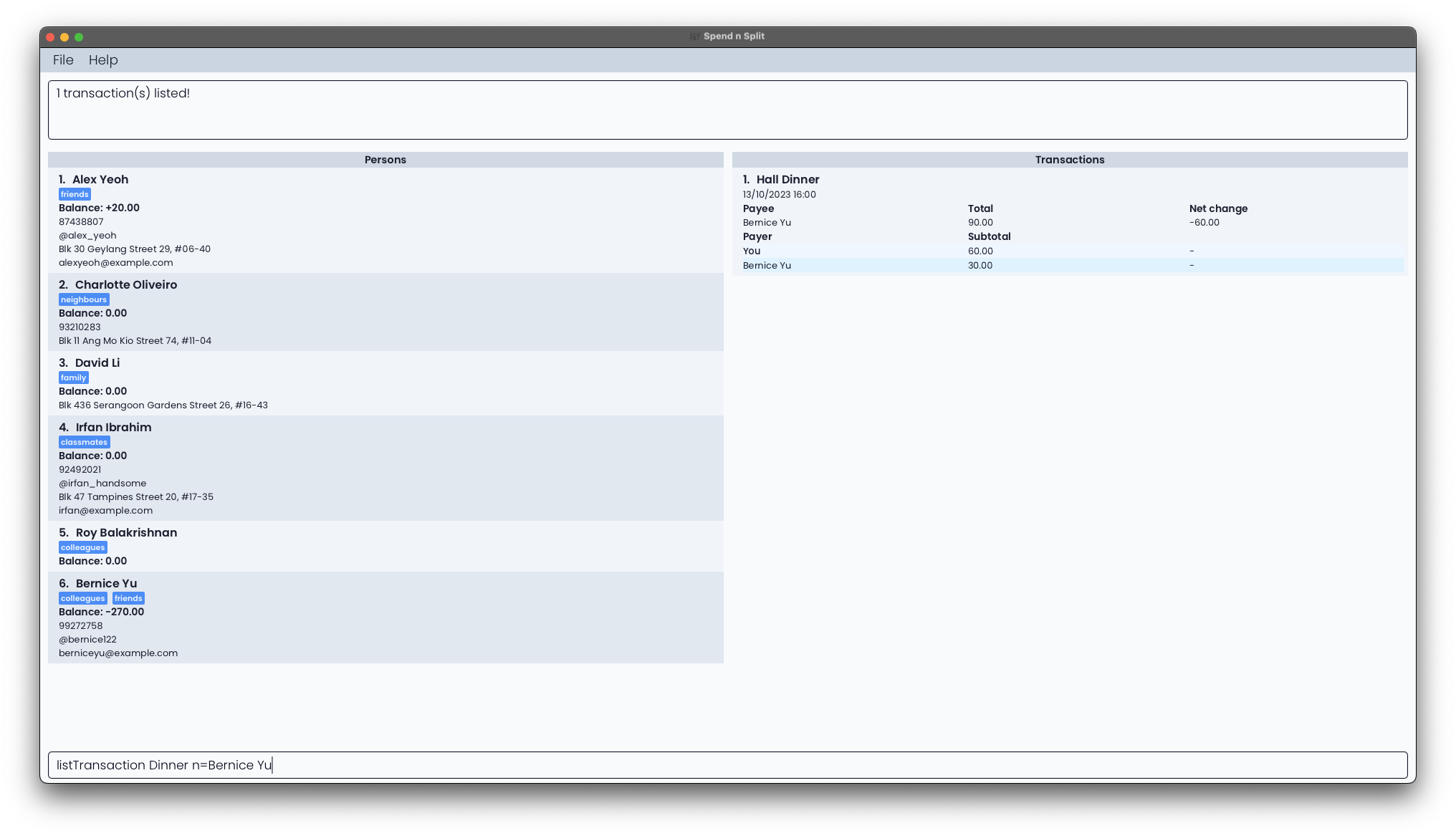
Settling transactions: settlePerson
Settles the outstanding balance with a person at the specified INDEX. The index refers to the index number shown in the displayed transaction list.
The outstanding balance refers to the overall balance calculated using only transactions that occur before or at the given timestamp.
A new transaction will be created in the application for the settlement of balances.
If no timestamp is given, the default timestamp is the current system time. If only the date is given, the default time is set as 23:59.
Format: settlePerson INDEX [ts=TIME]
Example:
-
settlePerson 1- Settles the outstanding balance with the 1st person in the displayed list.
Sample Execution:
$ settlePerson
Invalid command format!
settlePerson: Settle any outstanding balance with another person.
If a timestamp is provided, the balance at the instant before
the timestamp is used. Else, the balance at the instant before
the current system time is used.
Parameters: INDEX (must be a positive integer) [ts=TIME]
Example: settlePerson 2 ts=13/10/2020 12:00
$ settlePerson 2 ts=13/10/2020 12:00
Balance settled: Alex Yeoh
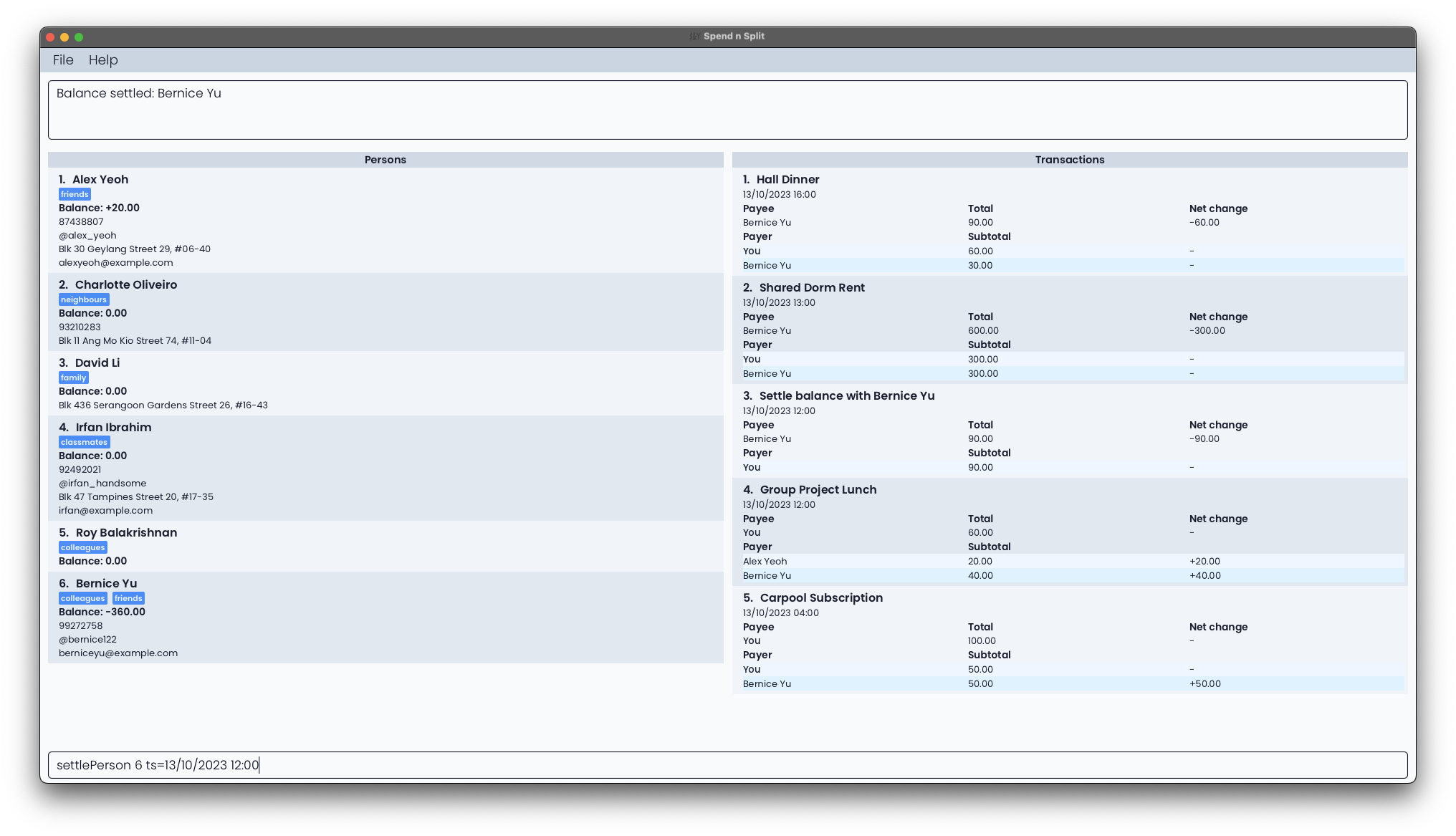
Other features
Setting shorthands for commands : setShorthand
Sets a shorthand for the original command. In the future, this shorthand can be used in place of the original command.
Format: setShorthand o=ORIGINAL_COMMAND s=SHORTHAND
The command word (setShorthand) has to be at the front of the command. The order of the remaining parameters is flexible. Commands and shorthands are case-sensitive.
Example:
-
setShorthand o=addTransaction s=at- Sets the shorthand
atfor the commandaddTransaction.
- Sets the shorthand

Getting help : help
Displays a URL that contains a link to this user guide.
Format: help

Clearing all entries : clear
Clears all entries from the application.
Format: clear
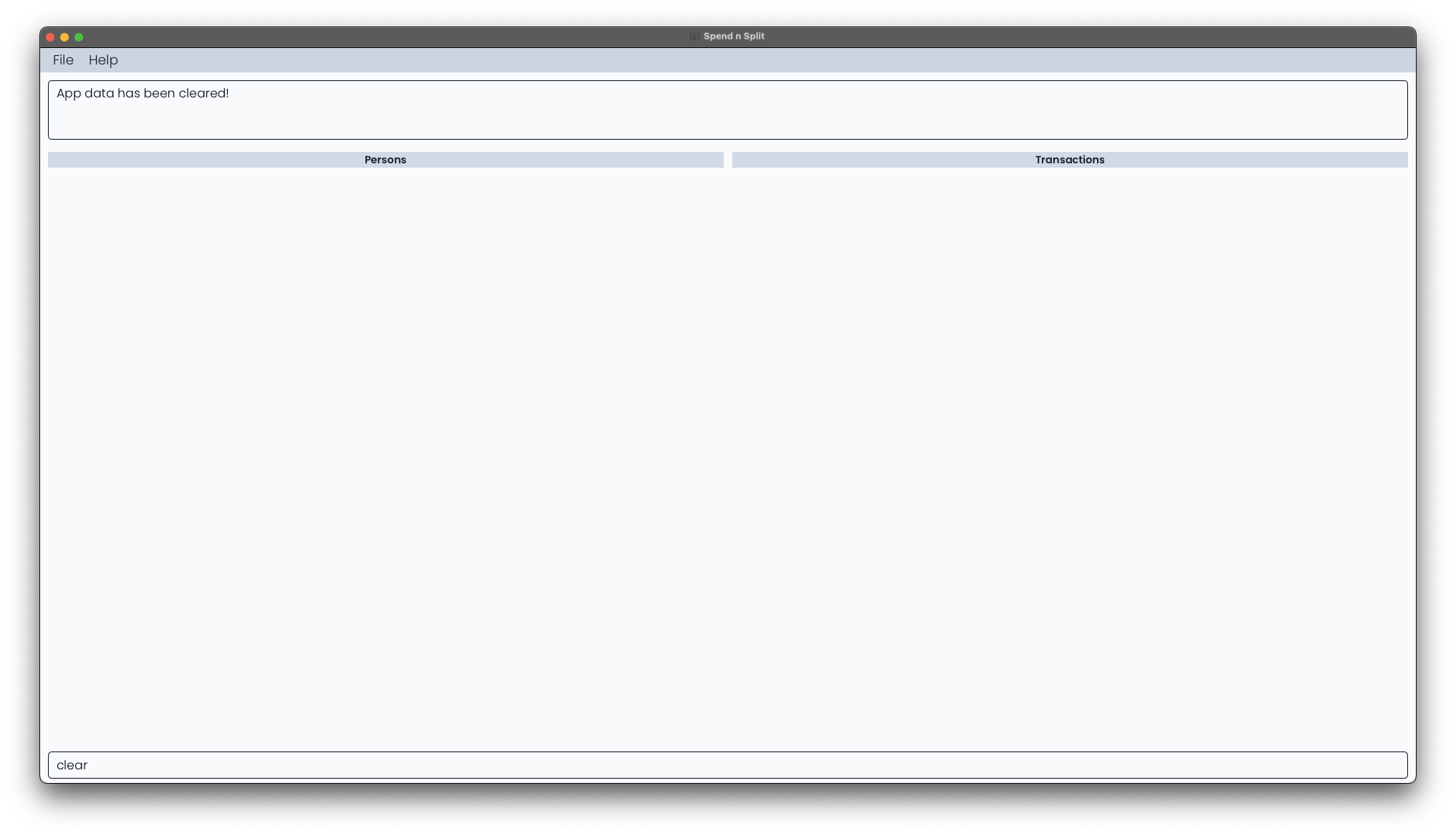
Exiting the program : exit
Exits the program.
Format: exit
Navigating the app using only the keyboard
You can use the following shortcuts to navigate our application:
- Selecting Result Display: [ALT (Windows/Linux) / OPTION (Mac)] + UP ARROW KEY
- Selecting Persons List: [ALT (Windows/Linux) / OPTION (Mac)] + LEFT ARROW KEY
- Selecting Transactions List: [ALT (Windows/Linux) / OPTION (Mac)] + RIGHT ARROW KEY
- Selecting Command Box: [ALT (Windows/Linux) / OPTION (Mac)] + DOWN ARROW KEY
For our result display, persons list and transaction list, once selected, you can use the UP ARROW KEY or DOWN ARROW KEY for scrolling.
Data
Saving the data
Data is saved in the hard disk automatically after any command that changes the data. There is no need to save manually.
Editing the data file
Data is saved automatically as a JSON file [JAR file location]/data/spendnsplitbook.json. The data is human-readable.
FAQ
1) Why do the portions in the transaction list not add up exactly to the balances of certain people?
The portions and balances displayed are rounded to a fixed number of decimal places. This means there may be fractional differences between the actual portions and what is displayed. Values are rounded to 2 decimal places (i.e. 0.149 will be rounded down to 0.14, and 0.145 will be rounded up to 0.15). The positive and negative signs will still be kept (i.e. -0.0000001 will be rounded down to -0.00, and -1.015 will be rounded up to -1.02).
Example:
If these are the stored balances of Roy and Tan in the application:
Roy: 12.122345
Tan: -10.223231
This is displayed instead in the application due to rounding off to 2 decimal places:
Roy: 12.12
Tan: -10.22
2) What happens when I enter an invalid command?
When an invalid command is input, an error message will be reflected at the output panel at the top of Spend N Split. The error message will vary depending on the type of error.
- Execution errors caused by invalid command format. This occurs when the command word
is recognised but there are missing parameters or parameters are
not supported.
The error message reflected
will state
Invalid command format!, before giving details on the command and the parameters required, along with an example of a correct command input with the parameters required.- Example:
settlePerson -1- Error message:
Invalid command format! settlePerson: Settle any outstanding balance with another person. Parameters: INDEX (must be a positive integer) Example: settlePerson 1
- Error message:
- Example:
![]() Note the differences between Execution errors and Input errors. An execution error refers to an error that will occur
regardless of the state of the application or its data, whereas input errors are errors that occur when certain conditions in the application
are met.
Note the differences between Execution errors and Input errors. An execution error refers to an error that will occur
regardless of the state of the application or its data, whereas input errors are errors that occur when certain conditions in the application
are met.
Attempting to settle the balance of a person at index 6 when there are only 5 people in the Person List, or attempting to add a person that has an identical name to someone that already exists in the Person List are both input errors.
Meanwhile, attempting to settle the balance of a person at index -1 will result in an execution error, as it will occur for every form of data in the application.
- Unknown command. This occurs when the command word is not recognised.
The error message reflected will state
Unknown command.- Example:
settleTransaction n=Ryan tg=@ryanzzzzz- Error message:
Unknown command
- Error message:
- Example:
- Input errors caused by invalid parameter values. This occurs when invalid parameter values are provided
for the valid command word. The error message reflected is dependent on the
valid command word.
- Example:
settlePerson 6when there are only 5 people in the Person List.- Error message:
The person index provided is invalid
- Error message:
- Example:
3) What is considered a relevant transaction?
A transaction is only considered relevant if it involves you owing or being owed money by someone from your contacts list. In a relevant transaction:
- “Self” must either be the payee, a payer, or both. You must be involved in the transaction.
- Include at least one person stored in the application (not “Self” or “Others”) as either the payee, a payer, or both. Someone else in your contacts list must be involved in the transaction.
If these conditions are not met, it means that the transaction does not affect your balance with anyone on your contract list, and hence is considered irrelevant.
Examples of relevant transactions:
- You are the payee for dinner. The payers are you, Alice and Bob.
- Bob pays for transport. You and Alice are riders, and hence are the payers.
In both these cases, you were involved as the payee or payer of the transaction, and so was another person in your contacts.
Examples of irrelevant transactions:
- Bob was the payee for dinner. The payers are Alice and Bob. You are not involved and hence, this transaction is irrelevant.
- You pay for transport for Zack. Zack is the only payer. Zack was then deleted from the contacts list afterwards, resulting in him being considered as “Others” in the transaction. This transaction becomes irrelevant and is automatically deleted from the transactions list when Zack is deleted.
Note:
- If you attempt to delete payers such that nobody from your Person List is involved in the transaction, the application will not execute your command. You are advised to delete the transaction if it no longer concerns you or anyone from your Person List.
- If you delete a person and it results in some transactions becoming irrelevant as highlighted in the second example of irrelevant transactions above, the application will automatically delete these irrelevant transactions.
Acknowledgements
We would like to acknowledge the following third-party libraries, frameworks and sources for their use in Spend N Split:
Development
-
Jackson: The Java JSON library for parsing and creating JSON for Spend N Split.
-
JUnit 5: The Java testing framework of Spend N Split.
-
Apache Common Numbers: The Java numbers library that enhance Spend N Split’s precision.
Gradle
-
Checkstyle: The Gradle plugin that ensures consistent and appropriate code style.
-
Shadow: The Gradle plugin for creating fat JARs for Spend N Split.
-
Jacoco: The Gradle plugin for generating code coverage reports.
User Interface
-
JavaFX: The GUI framework of Spend N Split.
-
Poppins Font: The primary font used in Spend N Split.
-
Tailwind CSS Colors: The colour palette that inspired the Spend N Split colour scheme.
Others
-
Address Book 3: The project Spend N Split is based on.
-
Jekyll: The static site generator that converts Spend N Split markdown documentation into web pages.
Glossary
Address
The particulars of the place where a person lives.
Alphanumeric
Consisting of only letters (a-z, A-Z) or numbers or both.
Amount
The total value of the transaction.
Balance
The amount of money that you owe a person or the amount of money that they owe you. A positive balance under a person means that they owe you money, whereas a negative balance means that you owe them money.
Card
A rectangular area in our application that either describes the full details of a transaction or person.
Command
To use and control the application, commands are necessary. To utilise a feature, a command has to be typed into the Command Input Field and executed.
Cost
The total value of the transaction.
Description
A written account of a transaction, used to provide context and details about the transaction.
Email address
A unique identifier for an email account. It identifies an email box to which messages and emails are delivered.
Field
An area where text can be input.
Flag
Flags are used to modify the operation of a command.
GUI
GUI stands for Graphical User Interface. A Graphical User Interface uses icons and mouse inputs from users to allow them to interact with the application.
Index
A number representing the position of an item in a list.
Integer
A number that is a not a fraction. E.g. whole numbers such as -10, 0, 1, 5.
Keyword
An important word that is used by the application to process various commands.
Name
A word or set of words that are used to address or refer to a person.
Negative
A numerical value that is less than 0.
Parameter
An additional input that provides further details on a command that a user is executing.
Payee
Refers to the person that paid for the transaction.
Payer
Refers to a person that owes the payee money for the transaction.
People
Used to refer to multiple persons. Can be used interchangeably with “persons”.
Person
An individual that can be associated with various information in our application, such as contact information and balances.
Phone number
A sequence of digits that is dialled on a telephone to contact a person.
Portion
A subset of a transaction. A transaction is split into multiple portions.
Positive
A numerical value that is greater than 0.
Settle
Refers to the act of two people exchanging money, such that their respective balances with each other equal zero after the transaction.
Shorthand
A shortened version of a command.
Tag
A label that can be applied to a person to provide additional details about them.
Telegram handle
A unique identifier for a Telegram account. E.g. @ryanlim123
Timestamp
Refers to the time the transaction occurred. Timestamps in our application are displayed in the “DD/MM/YYYY HH:MM” format. DD refers to Day, MM refers to Month, YYYY refers to Year, HH refers to the 24-hour notation for Hour, and MM refers to Minute.
Transaction
An interaction of buying or selling something where the exchange of money occurs.
Weight
A numerical value assigned to each person that is involved in a transaction. It is used to calculate the amount of money that a person should pay for their share of the transaction.